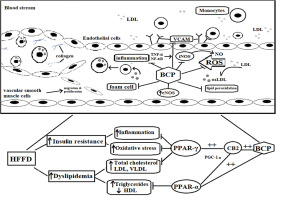Chemico-Biological Interactions ( IF 4.7 ) Pub Date : 2018-10-19 , DOI: 10.1016/j.cbi.2018.10.010 Dareen A. Youssef , Hassan M. El-Fayoumi , Mona F. Mahmoud

|
Beta-caryophyllene (BCP) is a phytocannabinoid possessing selective agonistic activity to cannabinoid type-2 receptors (CB2R) and peroxisome proliferator-activated receptors-α (PPAR-α). However, few studies reported the contribution of PPAR-γ receptors in BCP effects. The aim of this study was to investigate the BCP effects on diet-induced dyslipidemia and vascular inflammation as well as the involvement of CB2R and PPAR-γ receptors. Wistar rats were fed a high-fat diet and administered 10% fructose for 12 weeks. Treatment with pioglitazone, BCP, BCP + CB2R antagonist, AM630, or BCP + PPAR-γ antagonist, BADGE was started from the 9th week and continued till the 12th week. BCP significantly ameliorated all diet-induced alterations in a CB2R-dependant manner as it improved glycemic parameters, dyslipidemia, and vascular oxidative stress and inflammation. It also downregulated proatherogenic adhesion molecule (VCAM-1) and restored vascular eNOS/iNOS expression balance. PPAR-γ was involved in BCP-evoked suppression of vascular inflammation, VCAM-1 and restoration of normal vascular eNOS/iNOS balance thus normal NO level. Furthermore, part of BCP hypolipidemic effects (lowering total cholesterol, LDL, VLDL) involved both CB2R and PPAR-γ receptors. BCP treatment was superior to pioglitazone in anti-inflammatory and anti-atherosclerotic measures. BCP may represent a more potent alternate to pioglitazone avoiding its side effects in the treatment of insulin resistance and vascular inflammation.
中文翻译:

β-石竹烯可预防饮食引起的血脂异常和大鼠的血管炎症:涉及CB2和PPAR-γ受体
β-石竹烯(BCP)是一种植物大麻素,对大麻素2型受体(CB2R)和过氧化物酶体增殖物激活的受体-α(PPAR-α)具有选择性激动活性。但是,很少有研究报道PPAR-γ受体在BCP效应中的作用。这项研究的目的是研究BCP对饮食引起的血脂异常和血管炎症以及CB2R和PPAR-γ受体的影响。给Wistar大鼠喂高脂饮食,并给予10%果糖,持续12周。吡格列酮,BCP,BCP + CB2R拮抗剂,AM630或BCP +PPAR-γ拮抗剂BADGE从第9周开始治疗,一直持续到第12周。BCP改善了血糖参数,血脂异常,以及血管的氧化应激和炎症。它还下调了促动脉粥样硬化粘附分子(VCAM-1),并恢复了血管eNOS / iNOS表达平衡。PPAR-γ参与了BCP引起的血管炎症,VCAM-1的抑制和正常eNOS / iNOS平衡的恢复,从而恢复了正常的NO水平。此外,部分BCP降血脂作用(降低总胆固醇,LDL,VLDL)涉及CB2R和PPAR-γ受体。在抗炎和抗动脉粥样硬化方面,BCP治疗优于吡格列酮。BCP可能是吡格列酮的更有效替代品,从而避免了它在治疗胰岛素抵抗和血管炎症中的副作用。PPAR-γ参与了BCP引起的血管炎症,VCAM-1的抑制和正常eNOS / iNOS平衡的恢复,从而恢复了正常的NO水平。此外,部分BCP降血脂作用(降低总胆固醇,LDL,VLDL)涉及CB2R和PPAR-γ受体。在抗炎和抗动脉粥样硬化方面,BCP治疗优于吡格列酮。BCP可能是吡格列酮的更有效替代品,从而避免了它在治疗胰岛素抵抗和血管炎症中的副作用。PPAR-γ参与了BCP引起的血管炎症,VCAM-1的抑制和正常eNOS / iNOS平衡的恢复,从而恢复了正常的NO水平。此外,部分BCP降血脂作用(降低总胆固醇,LDL,VLDL)涉及CB2R和PPAR-γ受体。在抗炎和抗动脉粥样硬化方面,BCP治疗优于吡格列酮。BCP可能是吡格列酮的更有效替代品,从而避免了它在治疗胰岛素抵抗和血管炎症中的副作用。在抗炎和抗动脉粥样硬化方面,BCP治疗优于吡格列酮。BCP可能是吡格列酮的更有效替代品,从而避免了它在治疗胰岛素抵抗和血管炎症中的副作用。在抗炎和抗动脉粥样硬化方面,BCP治疗优于吡格列酮。BCP可能是吡格列酮的更有效替代品,从而避免了其在治疗胰岛素抵抗和血管炎症中的副作用。











































 京公网安备 11010802027423号
京公网安备 11010802027423号